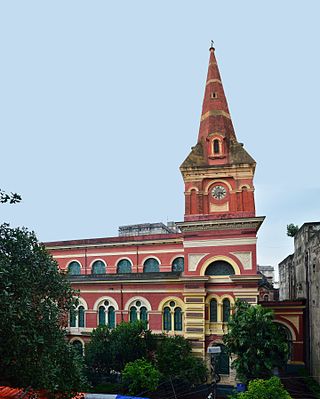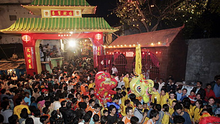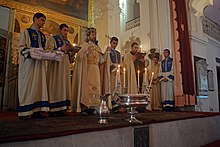
Kolkata is the capital and largest city of the Indian state of West Bengal. It lies on the eastern bank of the Hooghly River, 80 km (50 mi) west of the border with Bangladesh. It is the primary financial and commercial centre of eastern and northeastern India. Kolkata is the seventh most populous city of India with an estimated city proper population of 4.5 million (0.45 crore). It is the centre of the Kolkata Metropolitan Region, one of the most populous metropolitan areas in the world with a population of over 15 million residents. Kolkata is the de facto cultural capital of India and historically and culturally significant city in the historic region of Bengal. It is the second largest Bengali-speaking city in the world. It has the highest number of Nobel laureates among all cities in India.
The history of the Jews in India dates back to antiquity. Judaism was one of the first foreign religions to arrive in the Indian subcontinent in recorded history. Desi Jews are a small religious minority who have lived in the region since ancient times. They were able to survive for centuries despite persecution and antisemitic inquisitions.

The association of Armenians with India and the presence of Armenians in India are very old, and there has been a mutual economic and cultural association of Armenians with India.

Tangra is a region in East Kolkata that traditionally housed many tanneries owned by people of Hakka Chinese origin.

The former communities of Jewish migrants and their descendants from Baghdad and elsewhere in the Middle East are traditionally called Baghdadi Jews or Iraqi Jews. They settled primarily in the ports and along the trade routes around the Indian Ocean and the South China Sea.
South Asian ethnic groups are an ethnolinguistic grouping of the diverse populations of South Asia, including the nations of Bangladesh, Bhutan, India, Maldives, Nepal, Pakistan, and Sri Lanka. While Afghanistan is variously considered to be a part of both Central Asia and South Asia, Afghans are generally not included among South Asians.

Tiretta Bazaar, also known as Chinatown, is a neighborhood near Lalbazar in Central Kolkata. It is usually called Old China Market. The locality was once home to 20,000 ethnic Chinese Indian nationals, but now the population has dropped to approximately 2,000. Most of the Hakka Chinese people in the area moved closer to Tangra. The traditional occupation of the Chinese Indian community in Kolkata had been working in the nearby tanning industry as well as in Chinese restaurants. The area is still noted for the Chinese restaurants where many people flock to taste traditional Chinese and Indian Chinese cuisine.
Chinese people in India are communities of Han Chinese and Tibetan origin and settlement. There are permanent communities descended from immigrants and refugees from China as well as an expatriate community in India on a temporary basis.
Armenian College and Philanthropic Academy (ACPA) is an Armenian school in Kolkata, India. As of 2015, it is the sole Armenian-centred school in the eastern section of the world, and has been so throughout its history. It is commonly known and called Armenian College.

There are many synagogues in the Indian subcontinent, although many no longer function as such and today vary in their levels of preservation. These buildings dating from the mid-sixteenth through the mid-20th century once served the country's three distinct Jewish groups—the ancient Cochin Jews, and Bene Israel communities as well as the more recent Baghdadi Jews.

Since its founding in 1625 by Dutch traders as New Amsterdam, New York City has been a major destination for immigrants of many nationalities who have formed ethnic enclaves, neighborhoods dominated by one ethnicity. Freed African American slaves also moved to New York City in the Great Migration and the later Second Great Migration and formed ethnic enclaves. These neighborhoods are set apart from the main city by differences such as food, goods for sale, or even language. Ethnic enclaves provide inhabitants security in work and social opportunities, but limit economic opportunities, do not encourage the development of English speaking, and keep immigrants in their own culture.

Ethnic groups in the Middle East, in the 'transcontinental' region which is commonly a geopolitical term designating the intercontinental region comprising West Asia without the South Caucasus, and also comprising Egypt in North Africa. The region has historically been a crossroad of different cultures and languages. Since the 1960s, the changes in political and economic factors have significantly altered the ethnic composition of groups in the region. While some ethnic groups have been present in the region for millennia, others have arrived fairly recently through immigration. The largest socioethnic groups in the region are Arabs, Turks, Persians, Kurds, and Azerbaijanis but there are dozens of other ethnic groups that have hundreds of thousands, and sometimes millions of members.

Magen David Synagogue is located at the junction of Brabourne Road and Canning Street in Kolkata. Magen David is the second operating synagogue in Kolkata, the other is the Beth El Synagogue at Pollock Street.

The history of the Jews in Kolkata, formerly known as Calcutta, in India, began in the late eighteenth century when adventurous Baghdadi Jewish merchants originally from Aleppo and Baghdad chose to establish themselves permanently in the emerging capital of the British Raj. The community they founded became the hub of the Judeo-Arabic-speaking Baghdadi Jewish trading diaspora in Asia.

Sir Apcar Alexander Apcar was a wealthy Armenian businessman in Calcutta, India. His family had made their fortune in the opium trade with China. He was president of the Bengal Chamber of Commerce, sat on the Imperial Legislative Council, and in 1903 was knighted. He owned a racehorse stud, and for several years was the leading figure in the Indian racing world.

Sir David Elias Ezra (1871-1947) was a prominent member of the Baghdadi Jewish community in Calcutta, India.

David Joseph Ezra was a leading merchant, property developer and communal leader of the Baghdadi Jewish community in Kolkata, India. He was one of the key developers behind nineteenth century Kolkata, and was responsible for many of its most celebrated Victorian buildings and synagogues.
Ezekiel Judah or Yehezkel Yehuda or Yahuda or Ezekiel Judah Jacob Sliman was a Jewish communal leader, trader of indigo, muslin, and silk, philanthropist, and talmudist of Baghdad. He migrated to India, leading the Baghdadi Jewish community of Kolkata in his lifetime and establishing the city's first synagogues.

Nahoum & Sons Pvt. Limited is an Indian bakery shop situated in West Bengal. It is one of the oldest surviving shops in Kolkata owned by the Jewish family. The products of Nahoum & Sons at Christmas are a part of the culture of Kolkata. Various famous personalities of India have eaten this foods of this bakery.
Shalom Aaron Obadiah Cohen was a Jewish jeweler and community leader known for founding the Jewish community in Kolkata in 1798 and engaging in the jewelry trade.





















